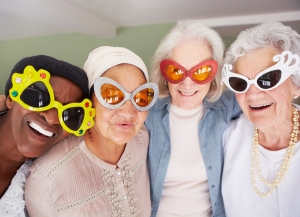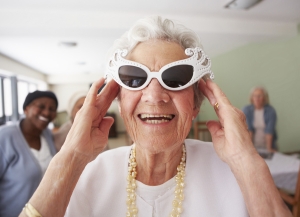As we get older, particularly into our 50’s and 60’s, cataracts can become a common eye condition experienced by both men and women. Cataracts are a leading cause of vision loss in the United States, so it’s important to know how to protect your eyes to reduce your risk for cataract and to be able to recognize the signs of a developing cataract.
Cataract Formation
Like the rest of the body, the eyes and the structures that support the visual system undergo significant change as we age. One of the structures that undergoes the most change is the lens in the eye. The lens of the eye is located behind the pupil and the colored iris. The lens helps to focus images onto the retina, which then transmits the images to the brain. Normally the lens is “crystal clear.”
Aging, and other medical conditions can cause the lens to become cloudy and yellow. This can cause mildly blurry vision, resulting in changes in your eyesight. If the crystalline lens loses significant transparency and clarity, then a cataract has formed. A cataract is the clouding of the eye’s lens, causing blocks or changes in the passage of light into the eye.
Vision Changes Due to Development of Cataracts
If you have cataracts, you may notice changes in your vision, such as:
- Difficulty seeing in dim illumination
- Difficulty with night driving
- Colors appear faded or dull
- Experiencing glare, haloes, or light sensitivity
- Diminished vision
The only way to treat cataracts is to remove them surgically. The longer cataracts are left untreated, the more difficult it can be to successfully remove the cataract and restore vision.
Cataracts can affect you even if you’ve had normal vision and relatively healthy eyes throughout your life. This is because, for most people, cataract development is a part of the normal aging process.
Risk Factors for Developing Cataracts
Certain health and lifestyle conditions and use of certain medications can increase your risk for developing cataracts, such as:
- diabetes
- trauma to the eye
- chronic inflammation of the eye
- other eye disease
- repeated sun exposure without using UV protective eyewear (on cloudy days also)
- long-term use of steroids, cortisone (including for asthma)
- other chronic inflammatory medical conditions
- smoking
- genetics, family history
Preserving Eye Health, Reducing Risk for Cataracts
Early detection and treatment of cataracts is critical to preserving your vision. Even though cataract formation may be an inevitable part of the aging process for many of us, there are things you can do to preserve eye health and reduce your risk for cataracts having a significant negative impact on your quality of life.
Move that Body. Moving your body enough to elevate your heart rate for 30 minutes each day is not just good for your heart, lungs, joints, and muscles—it’s good for your eyes. Whatever you enjoy for movement, do it. Exercise, such as walking, swimming, yoga, tai chi, weight training, hiking, increases circulation, carrying oxygen-rich blood and nutrients to all the vital organs, including the eyes.
Get More Greens. Dark, leafy green vegetables contain antioxidants, vitamins A and C, and minerals that support the health of the eyes (and the whole body!). Increase your intake of broccoli, collards, spinach, dark leaf lettuces, sprouts, etc. to obtain these nutrients.
Be Cool, Wear Shades. UV-protective eyewear is essential year-round. In the summer, the days are longer, and sun exposure increases as we spend more time outdoors. In winter, the sun is lower in the sky and often can feel like it’s “at eye level” with us while we drive or are outdoors. Just because it is colder outside, does not diminish the impact of UV light on our eyes. If you boat or engage in winter sports, the glare of the sun off the water and the snow increases the damaging effects of UV rays. So…no matter the season, you’ve got to wear shades!
If you are concerned about changes in your vision, or experiencing any of the symptoms listed, it may be time to adopt healthier habits, make changes in your vision care plan, or consult with an ophthalmologist. The health and wellness team at each of the Everbrook Senior Living communities are here to support and guide you.
Resources
American Academy of Ophthalmology “What are Cataracts?” https://www.aao.org/eye-health/diseases/what-are-cataracts
Prevent Blindness https://preventblindness.org/cataract-awareness-june-2022/




